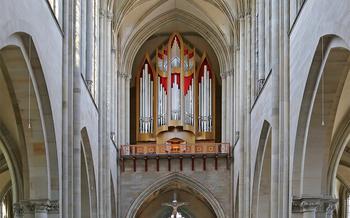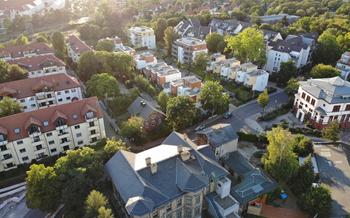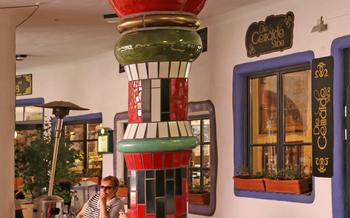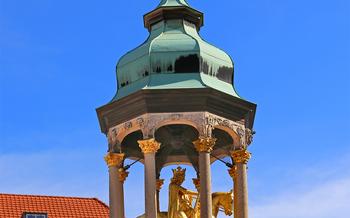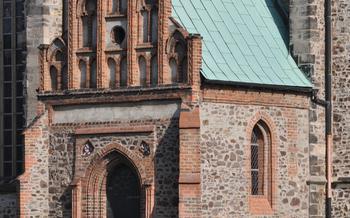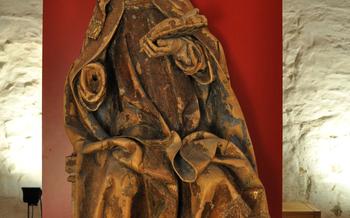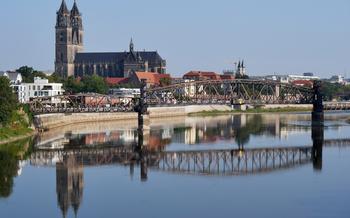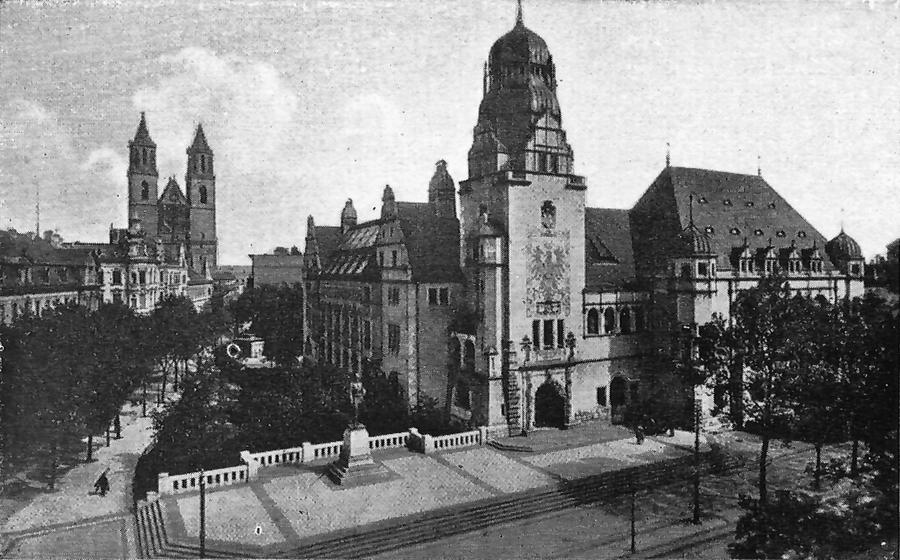
Kulturhistorisches Museum Magdeburg
- History and Significance:
- Collections and Exhibits
- Architecture and Ambiance
- Permanent Exhibitions:
- Educational Programs and Workshops:
- Guided Tours and Audio Guides:
- Accessibility and Facilities:
- Hours of Operation and Admission Fees:
- Location and Transportation
- Best Time to Visit
- Photography and Social Media
- Souvenirs and Gifts
- Sustainability and Environmental Practices
- Insider Tip: Unveiling Hidden Treasures
History and Significance:
The Kulturhistorisches Museum Magdeburg, founded in 1906, is a treasure trove of cultural and historical artifacts that narrate the captivating story of Magdeburg and its region. Over the decades, it has grown into a renowned institution, recognized locally and internationally for its exceptional collections and contributions to preserving the city's rich heritage. The museum's dedication to showcasing the diverse facets of Magdeburg's past, from prehistoric times to the present, has earned it a reputation as a must-visit destination for history enthusiasts, art lovers, and anyone seeking a deeper understanding of this vibrant city.
Collections and Exhibits
The Kulturhistorisches Museum Magdeburg houses a diverse range of collections that span various periods of history and culture. From prehistoric artifacts and archaeological finds to medieval treasures and contemporary artworks, the museum offers a comprehensive journey through the region's rich heritage.
Among the highlights of the collection is an impressive array of archaeological discoveries, including tools, weapons, and pottery from the Stone Age, Bronze Age, and Iron Age. These artifacts provide a glimpse into the lives and customs of the earliest inhabitants of the region.
The museum also boasts a significant collection of medieval art and artifacts, including sculptures, paintings, and religious objects. These works showcase the artistic and cultural achievements of the period, reflecting the region's strong ties to the Catholic Church and the Holy Roman Empire.
Additionally, the museum features a notable collection of modern and contemporary art, with works from local, national, and international artists. This collection represents the diverse artistic movements and trends of the 20th and 21st centuries, offering visitors a glimpse into the region's vibrant contemporary art scene.
To enhance the visitor experience, the museum regularly organizes special and rotating exhibitions that focus on specific themes or artists. These exhibitions provide an opportunity to delve deeper into particular aspects of the region's history, culture, and art, offering fresh perspectives and insights.
Architecture and Ambiance
The Kulturhistorisches Museum Magdeburg is housed in a striking building that blends classical and modern architectural elements. The original structure, dating back to the late 19th century, features a grand neoclassical façade with intricate carvings and sculptures. This façade has been carefully preserved and restored, lending a sense of historical charm to the museum.
In contrast to the traditional exterior, the museum's interior has been transformed with contemporary interventions. Spacious galleries and open-plan exhibition spaces create a light and airy atmosphere, allowing visitors to move freely and explore the collections. The use of glass and steel elements adds a touch of modernity, creating a harmonious dialogue between old and new.
Throughout the museum, visitors can discover unique architectural features that contribute to its overall ambiance. A grand staircase with ornate railings leads visitors to the upper floors, offering glimpses of the museum's diverse collections. Courtyards and skylights provide natural light, creating a bright and inviting environment. The thoughtful integration of architecture and art creates a memorable and immersive experience for visitors.
Permanent Exhibitions:
A journey through time awaits visitors at the Kulturhistorisches Museum Magdeburg, where a diverse range of permanent exhibitions showcases the city's rich history and diverse cultural heritage. Explore the fascinating world of archaeology in the "Archaeology of Central Germany" exhibition, where prehistoric artifacts and discoveries from the region shed light on the lives of our ancestors. Delve into the artistic treasures of the "Art and Cultural History" collection, featuring paintings, sculptures, and decorative arts that span centuries. Learn about the vibrant history of Magdeburg in the "Magdeburg History" exhibition, which brings to life the city's significant events, personalities, and transformations. Don't miss the "Natural History" exhibition, where captivating displays of local flora and fauna provide insights into the ecological wonders of the region. Each permanent exhibition offers a unique perspective on Magdeburg's past and present, ensuring a captivating and enriching experience for visitors.
Educational Programs and Workshops:
The Kulturhistorisches Museum Magdeburg offers a wide range of educational programs and workshops tailored to cater to diverse age groups and interests. These programs are designed to enhance visitors' knowledge and appreciation of history and culture. For children and families, the museum conducts interactive workshops, storytelling sessions, and hands-on activities that make learning fun and engaging. School groups can benefit from guided tours and educational programs aligned with their curricula, providing a unique and immersive learning experience. Additionally, the museum organizes lectures, workshops, and special events throughout the year, inviting experts and scholars to share their insights on various historical topics, offering visitors opportunities for deeper exploration and engagement with the museum's collections.
Guided Tours and Audio Guides:
Enhance your museum experience by taking advantage of the guided tours offered in various languages. These tours provide an in-depth exploration of the museum's highlights, with knowledgeable guides sharing fascinating stories and insights about the collections. Whether you're interested in the history of Magdeburg, the lives of notable figures, or the artistic techniques used in the exhibits, a guided tour will deepen your understanding and appreciation.
For those who prefer a more independent exploration, audio guides are available in multiple languages. These self-guided tours allow you to move at your own pace and focus on the exhibits that capture your interest. With detailed commentary and multimedia content, the audio guides provide a rich and informative experience, ensuring you don't miss any of the museum's treasures.
Accessibility and Facilities:
The Kulturhistorisches Museum Magdeburg is committed to providing an accessible and inclusive environment for visitors of all abilities. Wheelchair users and visitors with limited mobility can easily navigate the museum's spacious galleries and corridors. Elevators connect the different floors, ensuring that all exhibits are accessible. Visitors can borrow wheelchairs from the museum's information desk.
For those with visual or hearing impairments, the museum offers a range of assistive devices, including audio guides with clear and concise descriptions of the exhibits. Visitors can also request sign language interpreters for guided tours upon advance notice. The museum's staff is well-trained to assist visitors with disabilities, ensuring a comfortable and enjoyable experience for all.
The museum also provides various facilities to enhance the visitor experience. A café with outdoor seating offers a delightful spot to relax and enjoy refreshments while taking in the museum's beautiful surroundings. A well-stocked gift shop offers a range of souvenirs and publications related to the museum's collections. Cloakrooms are available for visitors to store their belongings securely. Clean and well-maintained restrooms are conveniently located throughout the museum.
Hours of Operation and Admission Fees:
-
The Kulturhistorisches Museum Magdeburg is open to the public from Tuesday to Sunday, with varying hours of operation depending on the day. On Tuesdays, Thursdays, and Fridays, the museum is open from 10 am to 6 pm, on Wednesdays from 10 am to 8 pm, on Saturdays from 10 am to 5 pm, and on Sundays from 11 am to 5 pm. The museum is closed on Mondays.
-
Admission fees for adults are set at 8 euros, while children and young people between the ages of 6 and 18 pay a reduced fee of 4 euros. Family tickets, valid for two adults and up to three children, are available for 16 euros.
-
The museum also offers free admission on the first Sunday of every month, making it an excellent opportunity for budget-conscious travelers.
Location and Transportation
The Kulturhistorisches Museum Magdeburg is conveniently situated in the heart of the city, on Otto-von-Guericke-Straße 68-7Visitors can easily reach the museum on foot from the city center or by taking public transportation. The nearest tram stop, "Kulturhistorisches Museum," is just a short walk away, providing direct connections to various parts of the city.
For those arriving by car, the museum offers ample parking spaces in the nearby car parks. Visitors can also explore the city by bicycle, as there are designated bike lanes and parking facilities in the area. The museum's central location makes it an ideal starting point for further exploration of Magdeburg's rich cultural heritage and vibrant urban landscape.
Best Time to Visit
The best time to visit the Kulturhistorisches Museum Magdeburg depends on your preferences and the type of experience you seek. For a more intimate and personal exploration, consider visiting during the off-season, typically from November to March. During this time, you'll encounter fewer crowds, allowing you to take your time and delve deeper into the exhibits without distractions.
If you're interested in attending special events or exhibitions, plan your visit accordingly. The museum hosts various temporary exhibitions throughout the year, each with its unique theme or focus. Check the museum's website or contact them directly for information on upcoming events.
To avoid the peak tourist season and ensure a more leisurely experience, steer clear of major holidays and school breaks when the museum tends to be busier. Opting for a weekday visit can also help you avoid the weekend crowds.
Regardless of when you choose to visit, the Kulturhistorisches Museum Magdeburg offers a rich and rewarding experience that will immerse you in the cultural and historical heritage of the region.
Photography and Social Media
The Kulturhistorisches Museum Magdeburg embraces the use of photography and social media as a way for visitors to share their experiences and connect with the museum's collections. Visitors are encouraged to take photos and videos for personal use, as long as they do not use flash photography or tripods. The museum also welcomes visitors to share their photos and experiences on social media using the designated hashtags #kulturhistorischesmuseummagdeburg and #museummagdeburg. By sharing their experiences online, visitors can help spread the word about the museum and its collections, inspiring others to visit and learn more about Magdeburg's rich cultural heritage.
Souvenirs and Gifts
The Kulturhistorisches Museum Magdeburg offers a delightful gift shop where visitors can find a treasure trove of souvenirs and gifts to commemorate their visit. From elegant reproductions of historical artifacts to charming postcards featuring museum highlights, there's something for every taste and budget. The gift shop is a perfect place to pick up a unique souvenir to remind you of your journey through time at the museum. Whether you're looking for a gift for a loved one or a special treat for yourself, the gift shop at the Kulturhistorisches Museum Magdeburg is sure to have something that will delight and inspire.
One of the unique items available in the gift shop is a replica of the famous "Magdeburg Rider," a 13th-century bronze statue that is one of the museum's most iconic exhibits. This miniature version of the statue is a wonderful way to take a piece of Magdeburg's history home with you. Another popular item is a set of postcards featuring stunning images of the museum's collections. These postcards are perfect for sending to friends and family to share your museum experience.
In addition to these traditional souvenirs, the gift shop also offers a selection of books and publications related to the museum's collections and exhibitions. These books are a great way to learn more about the history and culture of Magdeburg and its surrounding region. Whether you're a history buff, an art enthusiast, or simply someone who enjoys learning new things, you're sure to find something of interest in the gift shop at the Kulturhistorisches Museum Magdeburg.
Sustainability and Environmental Practices
The Kulturhistorisches Museum Magdeburg embraces sustainable practices to minimize its environmental impact. The museum utilizes energy-efficient lighting and heating systems to conserve energy. It also actively promotes recycling and waste reduction throughout its premises. Visitors are encouraged to contribute to these efforts by properly disposing of their waste and using reusable water bottles. The museum's commitment to sustainability extends beyond its own operations. It collaborates with local organizations to raise awareness about environmental issues and promote sustainable practices within the community. This dedication to sustainability demonstrates the museum's commitment to preserving both cultural heritage and the environment for future generations.
Insider Tip: Unveiling Hidden Treasures
Venture beyond the main exhibition halls and discover the hidden treasures that lie within the Kulturhistorisches Museum Magdeburg. In a secluded corner, tucked away from the bustling crowds, you'll find a remarkable collection of medieval manuscripts and illuminated texts. These beautifully preserved artifacts offer a glimpse into the region's rich literary and artistic heritage. Spend some time poring over the intricate illustrations and calligraphy, and let your imagination transport you back to a time when monks and scholars meticulously crafted these masterpieces. This hidden gem is a testament to the museum's commitment to preserving and showcasing the diverse cultural heritage of Magdeburg.
